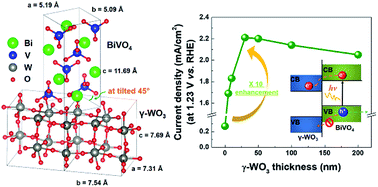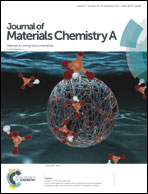Template-engineered epitaxial BiVO4 photoanodes for efficient solar water splitting†
Abstract
Bismuth vanadate (BiVO4) has attracted significant attention as a promising photoanode material for hydrogen production via photoelectrochemical (PEC) water splitting because of its narrow optical band gap and suitable band edge positions for water oxidation. However, the actual photoactivity of BiVO4 is considerably limited by its poor electron transport and slow water oxidation kinetics. Although several studies have been carried out to improve its photo-efficiency via the enhancement of electron transport and water oxidation kinetics, only a few studies have reported the growth of epitaxial BiVO4 to explore the fundamental properties of BiVO4 for PEC water splitting because extremely flat epitaxial films exhibit poor photo-efficiency because of their low surface-active area. However, studies of epitaxial BiVO4 still have the potential to provide new routes for improving its photo-efficiency. In this study, the growth of epitaxial BiVO4 is investigated using a thin γ-WO3 template layer deposited on a SrTiO3(001) substrate covered by a SrRuO3 (SRO) bottom electrode using pulsed laser deposition. Consequently, at 1.23 V vs. the RHE (reversible hydrogen electrode), the photocurrent density of epitaxial BiVO4 on the γ-WO3 template layer (2.20 mA cm−2) is approximately 10 times that of bare BiVO4, related to the effective charge transfer by the γ-WO3 intermediate layers and the subsequent increase in the surface-active area of epitaxial BiVO4. These results strongly suggest that epitaxial BiVO4 grown using a template layer can be a cornerstone for the in-depth understanding of the fundamental properties of BiVO4 for PEC water splitting.



 Please wait while we load your content...
Please wait while we load your content...